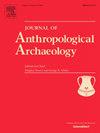家,壁炉和家务:在秘鲁瓦里帝国发现移民的不同方法
IF 2.2
1区 社会学
Q1 ANTHROPOLOGY
引用次数: 0
摘要
关于秘鲁是否存在瓦里帝国的争论持续了几十年。尽管定居模式发生了变化,大规模的景观发生了变化,但研究人员还是质疑瓦里人的霸权地位,因为“帝王烙印”陶瓷的流行和质量。这些文物主要来自坟墓,可以归因于声望交换网络或政治派别的标志。近年来,对考古家庭的研究通过考虑不同类型的移民,重塑了对瓦里扩张的看法:那些来自核心地区的人,那些在地区内移动的人,或者在省与省之间移动的人。在本文中,我提倡家庭考古学,关注家庭集合,关注日常活动的有形特征,作为超越征服者与被征服者的叙述和对可变物品的依赖的手段,这可能仅限于精英和/或掩盖参与帝国项目的人的地区起源。家庭考古学能够更好地发现与战争有关的殖民定居点的文化差异,在那里,来自不同文化背景的当地人和移民彼此互动,以不同的方式作为国家代理人参与政治,形成区域化的传统,并在几代人的过程中改变了一些做法,同时保留了其他做法。本文章由计算机程序翻译,如有差异,请以英文原文为准。
Home, hearth, and housekeeping: Alternative methods for detecting migrants in the Wari Empire, Peru
The existence of a Wari Empire in Peru was debated for several decades. Despite shifts in settlement patterns and large-scale landscape transformations, researchers questioned Wari hegemony based on the prevalence and quality of “imperially branded” ceramics. These artifacts were predominantly from tombs and could be attributed to a network of prestige exchange or markers of political affiliation. In recent years, studies of archaeological households have reshaped perspectives on Wari expansion by allowing for different types of migrants: those originating in the core, those moving within regions or moving between provinces. In this paper I advocate for household archaeology, a focus on domestic assemblages, and attention to the tangible features of quotidian activities as the means to move beyond narratives posing the conquerors vs. the conquered and a reliance on diacritical goods, which may be limited to the elite and/or mask the regional origin of people participating in imperial projects. Household archaeology is in a better position to detect culture differences in Wari-affiliated colonial settlements, where locals and migrants from diverse cultural backgrounds interacted with each other, differentially participated in the polity as state agents, formed regionalized traditions, and changed some practices, while retaining others, over the course of several generations.
求助全文
通过发布文献求助,成功后即可免费获取论文全文。
去求助
来源期刊

Journal of Anthropological Archaeology
Multiple-
CiteScore
4.00
自引率
11.10%
发文量
64
期刊介绍:
An innovative, international publication, the Journal of Anthropological Archaeology is devoted to the development of theory and, in a broad sense, methodology for the systematic and rigorous understanding of the organization, operation, and evolution of human societies. The discipline served by the journal is characterized by its goals and approach, not by geographical or temporal bounds. The data utilized or treated range from the earliest archaeological evidence for the emergence of human culture to historically documented societies and the contemporary observations of the ethnographer, ethnoarchaeologist, sociologist, or geographer. These subjects appear in the journal as examples of cultural organization, operation, and evolution, not as specific historical phenomena.
 求助内容:
求助内容: 应助结果提醒方式:
应助结果提醒方式:


